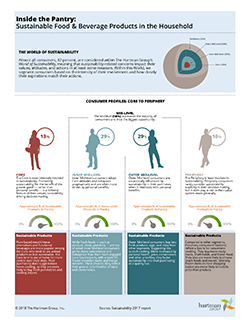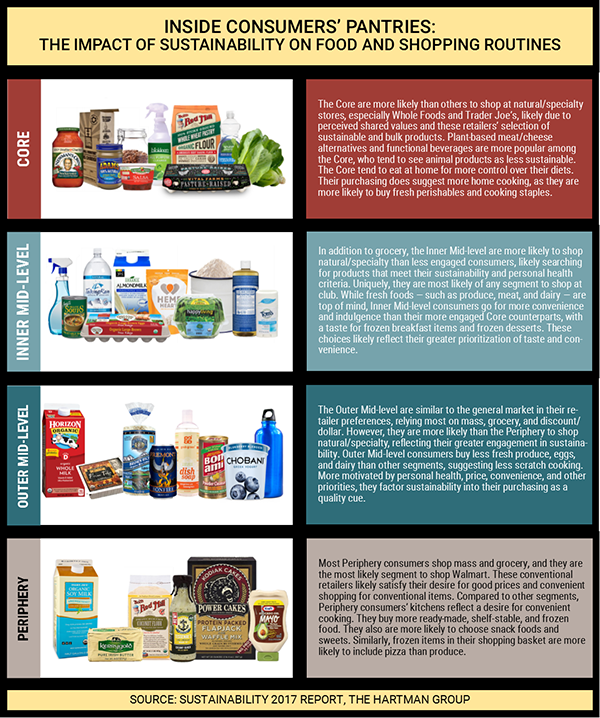Inside the Pantry: A Revealing Look at the Impact of Sustainability on Food and Beverage Product Purchases
More than a quarter of consumers claim that environmental and social concerns impact much of their purchasing.
 Today’s marketers face an ongoing challenge: how do you target consumers who are evolving with products and practices along their own sustainability continuum? Because consumers are not all following the same road map as they advance in their sustainability journey, there are no hard and fast rules about how to get their attention or determine what aspect of sustainability is going to most influence their purchase decisions.
Today’s marketers face an ongoing challenge: how do you target consumers who are evolving with products and practices along their own sustainability continuum? Because consumers are not all following the same road map as they advance in their sustainability journey, there are no hard and fast rules about how to get their attention or determine what aspect of sustainability is going to most influence their purchase decisions.
What’s the best way then to talk about sustainability consumers?
As observers of consumer behaviors and culture for nearly 30 years, The Hartman Group has been examining where sustainability fits into consumer lifestyles. We developed our world-model view to help companies understand how consumers are interacting with sustainable products. The first thing we want to know is who are the actors in this world; who is participating?
We believe this world perspective can be applied to any product or service category, such as sustainability, that has a significant lifestyle component. A world perspective is a way of conceptualizing consumer behavior around a “world” of activity.
Most consumers are currently aware of sustainability as a term. However, attitudes, depth of knowledge, and engagement differ according to where they are within (or outside of) the “World of Sustainability.”
Consumers who claim to not ever think about social concerns, environmental issues, or a host of other things related to sustainability or who don’t think they are really that important when buying products are those we consider to be outside the World of Sustainability. What this simply means is that they are unlikely to attitudinally or behaviorally interact with sustainable products. This is only 13 percent of consumers, according to our Sustainability 2017 report. The other 87 percent of consumers are those we consider to be within the World of Sustainability.
Within this world, there are different levels of participation and passion on the part of consumers. The most engaged consumer is the Core consumer (13 percent ); these are the ones who are walking the talk and going out of their way to live their beliefs and are paying more for sustainable products. At the opposite end of the spectrum, we have the Periphery consumer (16 percent), someone who is really not that involved yet behaviorally but is definitely someone who is attitudinally inclined. In between, there are the Outer (29 percent) and Inner (29 percent) Mid-level. Here we have people who are more like the Core (the Inner Mid-level) and people who are a little more like the Periphery (the Outer Mid-level).
The Mid-level are consumers who are starting to make purchase changes and are starting to buy sustainable products, but they are not as engaged or as passionate as the Core.
Inside the Pantry: A Window on Opportunities
 The qualitative phase of our Sustainability 2017 report provides a window on the growth potential for sustainable products. One important aspect of the ethnographic research was analyzing consumers’ household pantries through the lens of sustainability. Since food and beverage is a central gateway to sustainable lifestyles, and in keeping with our other research on food culture, we examine household pantries as partial barometers of the intensity of consumer involvement in something like the World of Sustainability.
The qualitative phase of our Sustainability 2017 report provides a window on the growth potential for sustainable products. One important aspect of the ethnographic research was analyzing consumers’ household pantries through the lens of sustainability. Since food and beverage is a central gateway to sustainable lifestyles, and in keeping with our other research on food culture, we examine household pantries as partial barometers of the intensity of consumer involvement in something like the World of Sustainability.
Our infographic (at right) illustrates the consumer participation and levels of engagement within the World of Sustainability (click to view full infographic). It also shows the approximate percentage of sustainable products within the household and describes the types of food and beverage products consumers by segment purchase through the lens of sustainability.
Examining consumer pantries from an ethnographic perspective complements analytic segmentations and sheds light on a very large and growing market that coalesces under the umbrella term “sustainable products.”
To underscore demand in the marketplace, we find that more than a quarter of consumers (26 percent) claim that environmental and social concerns always or usually always impact much of their purchasing. As a result, buying habits are changing: 22 percent of consumers said they have increased purchasing of sustainable products in the past year (up three points from 2015).
The image below depicts consumers’ views, from the Core to the Periphery, of the impact of sustainability on food and shopping routines (click to view full image).
This is clear evidence that sustainability is becoming more prevalent in consumers’ attitudes and actions. When shopping, consumers want products that are…
Core: future-focused, thoughtful, fair, promoting a healthy system of production
Inner Mid-level: healthier, less processed, organic, supporting the local community, not contaminating the environment, less packaged
Outer Mid-level: healthier, less processed, organic, benefiting workers, from small, local producers
Periphery: unique, great tasting, convenient, local, made by companies that innovate and give back
Sustainability is an important consideration for other demographic groups as well, especially Millennials. Specifically, we see that environmental and social concerns are more important purchasing considerations for:
- Millennials (33 percent always/usually vs Gen X 23 percent and Boomers 20 percent)
- Parents (31 percent always/usually vs 24 percent for those without children <18 in the house)
These groups are also more likely to say they’ve increased their sustainable purchasing in the past year:
- Millennials and Gen X (23 percent and 25 percent vs 19 percent Boomers)
- Women (25 percent vs 20 percent men)
- Parents (27 percent vs 20 percent for those without kids)
In the context of sustainability, consumers are becoming more purposeful in their consumption. Though the gap between aspiration and action varies with consumers’ level of engagement with sustainability, we see this “conscious consumerism” only gaining power and momentum in the future.
About Sustainability 2017 Report
Sustainability 2017 tracks and investigates how consumers understand, prioritize, and connect four zones (personal, social, environmental, and economical), exploring differences between consumer demand for and actual purchasing of sustainable products and attitudes toward corporate transparency issues. The report updates understandings of their evolving attitudes, behaviors, and aspirations regarding sustainability, including category adoption and the ways in which sustainability and transparency concepts manifest in consumer discourse. Click here to view special reduced pricing

